New Mexico’s unique climate, with its abundant sunshine, low humidity, and distinct seasons, creates both opportunities and challenges for gardeners. Choosing the best flowers to grow in New Mexico is essential for a thriving and colorful garden across its diverse regions, from arid deserts to cooler mountain areas.
Many gardeners face difficulties with dried-out blooms, unpredictable frosts, or scorching summer heat. The good news is that a variety of resilient and vibrant flowers are perfectly suited to the Land of Enchantment’s unique environment. This guide will help you discover the best flowers to grow in New Mexico—plants that not only survive but truly flourish.
From drought-tolerant native species to long-blooming perennials, these 12 exceptional flower varieties will brighten outdoor spaces with color and life. Whether you are new to gardening or experienced, finding the best flowers to grow in New Mexico can turn any yard into a beautiful, low-maintenance paradise.
Perennials for New Mexico
Purple Coneflower (Echinacea purpurea)
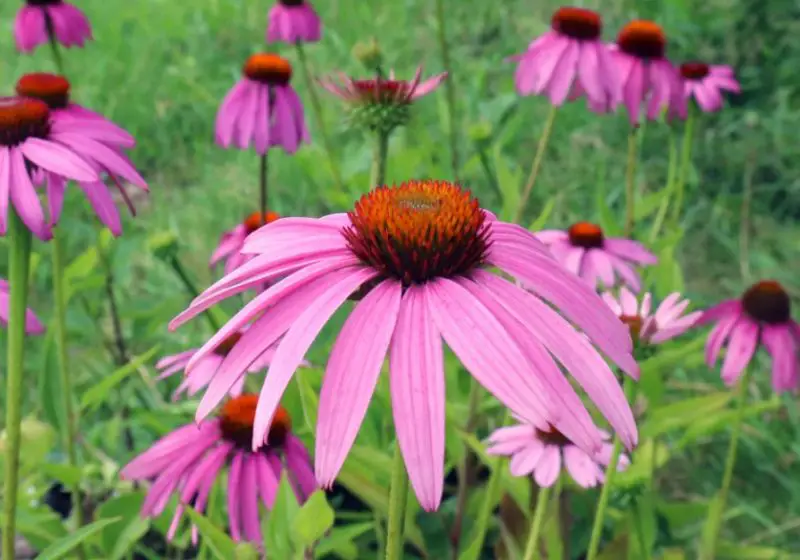
Purple Coneflower is a tough and resilient perennial known for its striking daisy-like flowers with vibrant purple petals and a prominent orange-brown central cone. It belongs to the daisy family and grows upright, typically reaching heights of 2 to 4 feet. Its lance-shaped leaves are rough to the touch, and the plant has a clumping growth habit. In New Mexico, this flower stands out in native landscapes and wildflower gardens for both its beauty and its ability to attract butterflies, bees, and even goldfinches that feed on its seeds.
This flower usually begins blooming in early to mid-summer and can continue well into fall, depending on the local conditions and care. In New Mexico, where the growing season can vary by elevation, Purple Coneflower generally begins blooming in June and lasts through September. It thrives in full sun but can tolerate light shade, and it prefers well-draining, slightly acidic to neutral soils. The bloom color may vary slightly depending on soil richness, but it most commonly presents bold, purple-pink petals.
To cultivate Purple Coneflower in New Mexico, plant it in early spring after the last frost or in the fall before the first frost. Space the plants about 18 inches apart to allow for good air circulation. Water regularly until established, after which the plant is quite drought-tolerant. Deadheading spent flowers will encourage continued blooming, though leaving some seed heads through fall and winter will provide natural food for birds. Adding a layer of mulch around the base will help retain soil moisture and suppress weeds in New Mexico’s arid climate.
Blanket Flower (Gaillardia pulchella)
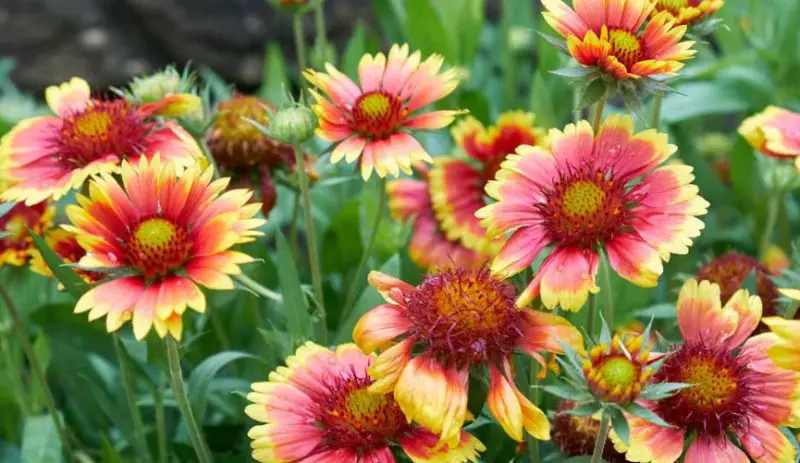
Blanket Flower is a cheerful, sun-loving wildflower native to the southwestern United States, including New Mexico. It features daisy-like blooms with rich red centers and vibrant yellow tips, giving a fiery appearance that adds energy to any garden. The plant typically grows 12 to 24 inches tall and spreads easily, forming a colorful ground cover in dry landscapes. Its fine-textured green foliage complements the bright flowers, and it attracts pollinators such as bees and butterflies.
In New Mexico, Blanket Flower begins blooming in late spring and continues until the first frost, often well into October. Its tolerance for heat and poor soil conditions makes it ideal for desert gardening. The flowers are long-lasting and appear continuously if deadheaded regularly. This flower thrives in full sun and requires well-draining soil, though it performs well even in sandy or rocky substrates. The blooms tend to fade in color with age but retain their visual appeal for extended periods.
To grow Blanket Flower successfully, sow seeds directly in the garden after the last frost or start indoors and transplant. Water regularly during the seedling stage, but once established, the plant requires very little supplemental watering. It is well-suited for xeriscaping and does not need fertilization, as rich soil can lead to leggy growth. Cutting back the plant midsummer may encourage a second flush of blooms. It is a short-lived perennial or annual in colder areas but often reseeds itself naturally in New Mexico gardens.
Russian Sage (Perovskia atriplicifolia)

Russian Sage is a semi-woody perennial shrub known for its elegant, upright form and clouds of soft lavender-blue flowers that bloom on long spikes. The silvery-gray, deeply lobed foliage is aromatic and gives the plant a light, feathery appearance. Typically growing 3 to 5 feet tall and wide, Russian Sage is often used in borders, xeriscapes, and pollinator gardens across New Mexico. Its airy habit and muted colors pair well with bolder flowers and help soften harsher desert landscapes.
This plant blooms from mid-summer to early fall, usually from July to September in New Mexico. The flowering period is long, and the plant often retains color even during periods of drought or extreme heat. Russian Sage prefers full sun and thrives in lean, well-draining soils, especially sandy or gravelly types that mimic its native Central Asian environment. The flowers attract bees and hummingbirds and provide a subtle, continuous color in the garden when many other plants begin to fade.
Russian Sage is best planted in spring after the last frost. It requires little care once established and performs best when not overwatered or overfed. In fact, too much fertilizer or rich soil can cause the stems to flop. Prune the plant back to 6–12 inches in early spring to encourage strong, upright growth. Although drought-tolerant, occasional deep watering during prolonged dry spells will help maintain its vigor. Mulching can be helpful in the early stages but is generally not necessary for mature plants.
Desert Marigold (Baileya multiradiata)
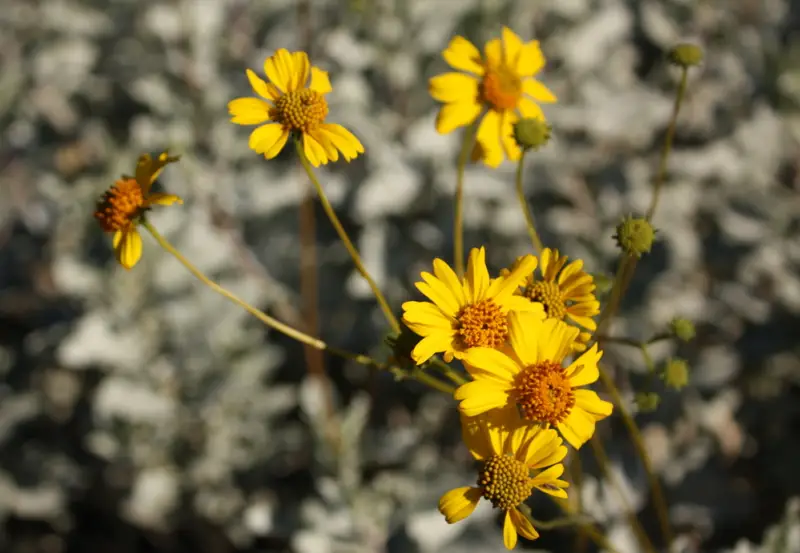
Desert Marigold is a tough, low-maintenance perennial perfectly adapted to the arid landscapes of New Mexico. It features bright yellow, daisy-like flowers that bloom on long, slender stems above a base of silvery, woolly leaves. This plant typically grows 12 to 18 inches tall and wide and forms attractive mounds that bring a cheerful pop of color to rock gardens, roadside plantings, and xeriscapes. Its silver foliage provides visual interest even when the plant is not in bloom.
In New Mexico, Desert Marigold starts blooming in spring, often as early as April, and can continue flowering through fall, depending on weather and moisture levels. The golden-yellow blooms are especially vibrant under strong sunlight and provide a valuable nectar source for bees, butterflies, and other native pollinators. While the individual flowers may last only a few days, the plant produces a steady succession of blooms throughout the warm months.
Growing Desert Marigold is simple. Sow seeds in well-draining soil after the last frost or plant transplants in a sunny spot. It requires little water once established and thrives on neglect, making it an excellent choice for low-water gardens. Deadheading spent flowers can prolong blooming, though the plant will often reseed itself naturally. It does not tolerate overwatering or rich soil, which can lead to root rot or leggy growth. In colder regions of New Mexico, it may behave as a short-lived perennial or reseeding annual.
Annuals for New Mexico
Zinnias (Zinnia elegans)
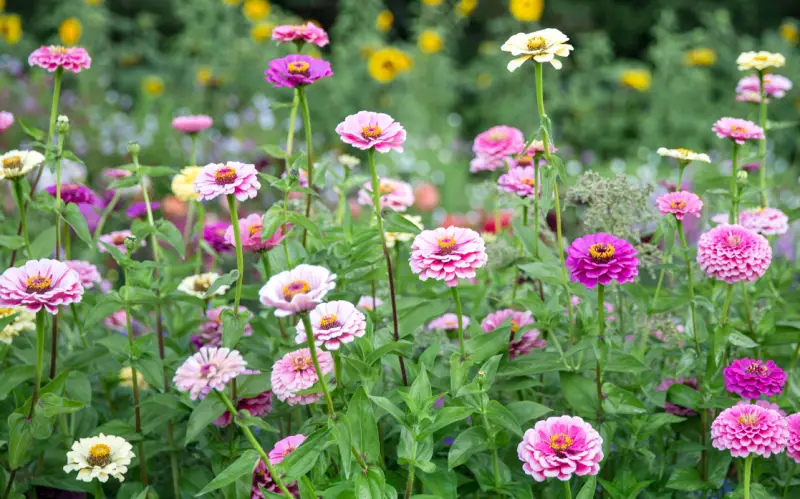
Zinnias are beloved annual flowers recognized for their vibrant color range, including red, pink, orange, yellow, white, and even bi-color varieties. These plants have a compact, bushy habit and produce large, solitary blooms that resemble dahlias or daisies, depending on the cultivar. In New Mexico gardens, zinnias are a popular choice for their fast growth and ability to provide continual color throughout the hottest months. They typically grow between 1 to 3 feet tall, with varieties available for borders, cutting gardens, or container planting.
Zinnias bloom profusely from late spring through the first frost, often starting in May or June in New Mexico and lasting into October in warmer areas. The flowers thrive in full sun and require well-draining soil to prevent fungal issues such as powdery mildew. Because of the region’s low humidity and bright light, New Mexico’s climate is well-suited for growing healthy zinnias with minimal disease pressure. The blooms attract butterflies and are ideal for cutting due to their long, sturdy stems.
To grow zinnias in New Mexico, sow seeds directly into the garden after the last frost, or start them indoors a few weeks earlier for an earlier bloom time. Space the plants 6–18 inches apart, depending on the variety, to ensure good air circulation. Regular deadheading encourages more blooms and keeps the plants looking tidy. Water deeply but infrequently, allowing the soil to dry between waterings. A light layer of mulch can help retain moisture during hot summer spells and suppress weed growth around the base of the plant.
Cosmos (Cosmos bipinnatus)
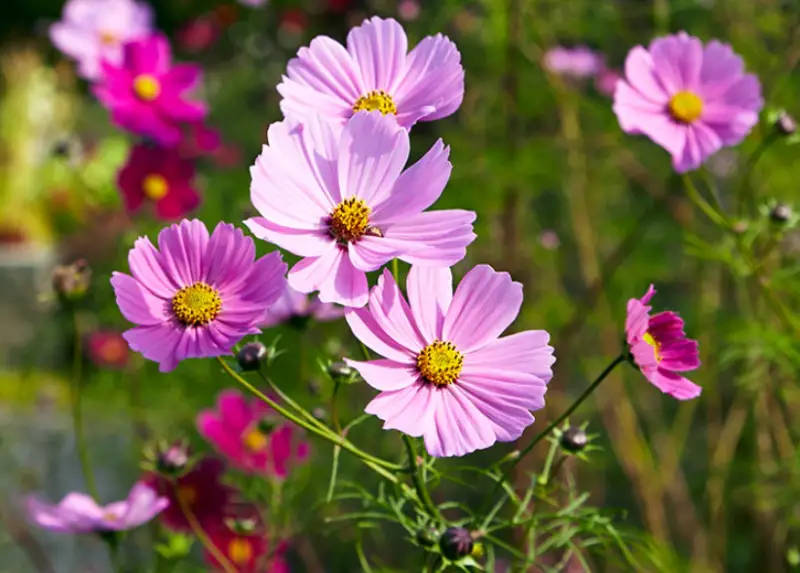
Cosmos are tall, graceful annuals known for their ferny foliage and delicate, daisy-like blooms that appear to float atop slender stems. Their flowers range in color from white and soft pinks to deep magenta, and they often feature yellow centers that contrast beautifully with their pastel petals. In New Mexico, cosmos are especially prized for their ability to thrive in full sun and poor soil conditions, making them ideal for low-maintenance or naturalized gardens.
The blooming season for cosmos begins in early summer and continues until the first frost, typically from June through October in most parts of New Mexico. These flowers are particularly suited to the state’s long, sunny days and do well even in nutrient-depleted or rocky soils. Though they may appear delicate, cosmos are drought-tolerant once established and will continue producing flowers with minimal input. The airy structure of the plant makes it an excellent backdrop in borders or as a filler in wildflower meadows.
To cultivate cosmos successfully, sow seeds directly into the ground after the last frost. They germinate quickly and grow rapidly, reaching heights of 3 to 5 feet depending on the variety. Thin seedlings to avoid overcrowding, which can lead to spindly growth. While cosmos require very little fertilization, adding a bit of compost at planting time can boost early growth. Regular deadheading will prolong blooming, and occasional watering during extended dry spells will help maintain vigor. Because they self-seed easily, cosmos often return year after year in New Mexico gardens.
Marigolds (Tagetes spp.)

Marigolds are classic garden annuals loved for their sunny, bold blooms and strong, often pungent scent. Their flower colors span from bright yellows and oranges to deep russet and gold, and they are typically globular or ruffled in shape depending on the species. In New Mexico, marigolds are a garden staple for their ability to withstand heat, intense sun, and relatively poor soils, making them ideal for borders, vegetable gardens, and containers alike.
These flowers bloom from late spring through fall, typically from May until the first frost in October. Marigolds are particularly useful in companion planting, as their scent is known to deter various garden pests like nematodes and aphids. Their cheerful flowers also attract pollinators such as bees and butterflies. Both French marigolds (Tagetes patula) and African marigolds (Tagetes erecta) are commonly grown in New Mexico, with the former being shorter and bushier and the latter producing larger blooms on taller plants.
To grow marigolds, plant seeds or transplants in full sun after the threat of frost has passed. These low-maintenance plants prefer well-draining soil and will perform well even in dry or sandy areas. Water regularly during establishment, then reduce frequency to promote deep roots and drought resilience. Deadheading spent flowers will encourage new blooms and prevent the plant from going to seed too early. Fertilization is rarely needed, as marigolds perform best in lean soil conditions, which help reduce excessive foliage growth and promote flowering.
Native & Wildflower Favorites
Penstemon (Penstemon spp.)
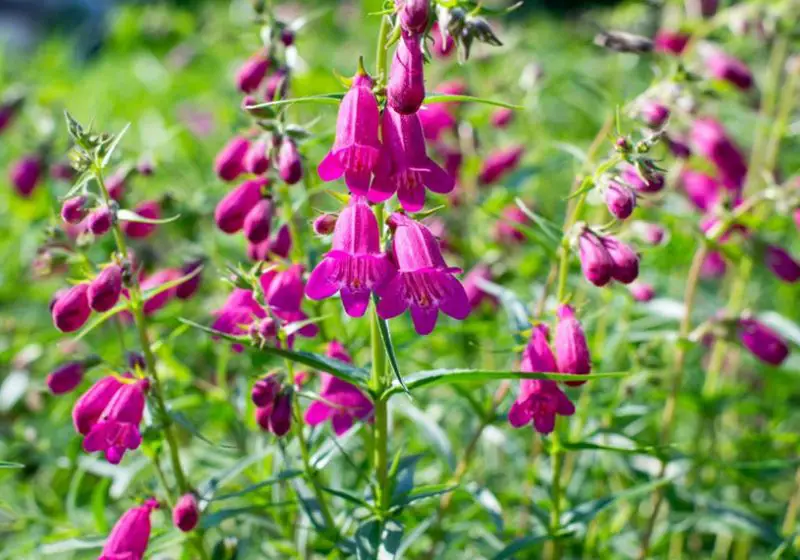
Penstemons, often called beardtongues, are striking perennials that produce tall spikes of tubular flowers in a range of colors including purple, blue, pink, red, and white. These flowers have a graceful, upright growth habit and bloom in succession along their stalks, attracting hummingbirds with their nectar-rich blossoms. With narrow, lance-shaped leaves and a bushy clumping form, penstemons lend texture and color to any New Mexico xeriscape or native garden.
Blooming from late spring through midsummer, penstemons thrive in New Mexico’s arid climate, especially in well-drained soils where other plants might struggle. Their ability to tolerate drought once established makes them an excellent choice for water-wise landscaping. Different species vary in height, ranging from 1 to 3 feet, and many native or adapted varieties grow naturally in the state’s high-desert and mountainous regions. Their flowers not only attract hummingbirds but also serve as an important nectar source for native bees.
To grow penstemons in New Mexico, choose a sunny site with sandy or rocky soil and excellent drainage. Overwatering can lead to root rot, so water deeply but infrequently after the plant is established. Mulch with gravel instead of organic matter to promote airflow around the crown. Deadhead spent blooms to extend the flowering season and consider cutting the plant back lightly in late summer to encourage bushier growth. These resilient perennials require minimal fertilization and can often reseed naturally, helping them return year after year in your garden.
Indian Blanket (Gaillardia aristata)
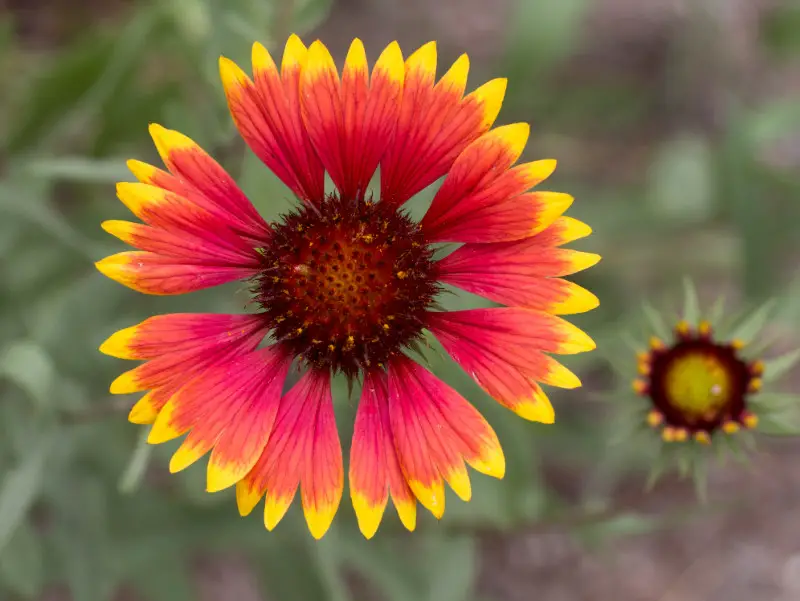
Indian Blanket, also known as perennial blanket flower, is a hardy, drought-tolerant native wildflower that displays brilliant daisy-like blooms in fiery shades of red, orange, and yellow. The petals are often bi-colored, with vibrant red centers and yellow-tipped edges that resemble a traditional Native American blanket, hence the name. In New Mexico, where the high-desert environment can be challenging for many plants, Indian Blanket thrives and provides vivid color all summer long.
Blooming from early summer through fall, Indian Blanket is perfectly adapted to the dry, sunny conditions found throughout much of New Mexico. It can grow in poor, rocky, or sandy soils and reaches about 12 to 24 inches in height. These resilient perennials attract butterflies and other pollinators while requiring very little care. Their long bloom period makes them a standout choice for naturalized meadows, borders, or mixed wildflower plantings in xeric landscapes.
To cultivate Indian Blanket in New Mexico, sow seeds directly into the soil in spring or fall. Choose a location with full sun exposure and excellent drainage. Once established, the plant is highly drought-tolerant and benefits from occasional deadheading to prolong flowering. Water sparingly—only during extended dry periods—and avoid rich soils or fertilizers, which can reduce blooming. With minimal care, Indian Blanket will naturalize over time and provide lasting color in tough growing conditions.
Desert Willow (Chilopsis linearis)

The desert willow is a small, deciduous tree or large shrub native to the arid Southwest, prized for its showy, trumpet-shaped flowers that resemble orchids. These blooms come in shades of pink, lavender, or purple and often have yellow or white throats with subtle streaks. Despite its name, the desert willow is not a true willow but is named for its long, narrow leaves that resemble willow foliage. In New Mexico landscapes, it serves as both a beautiful ornamental and a hardy survivor in desert environments.
Desert willow typically blooms from late spring through early fall, offering extended periods of color when many other desert plants have already faded. It thrives in the heat, requires little water once established, and is especially suited to USDA Zones 7–10. The flowers attract hummingbirds, bees, and butterflies, while the tree itself provides light shade and a graceful presence. Reaching heights of 15 to 30 feet, it can be grown as a single-trunked tree or a multi-stemmed shrub, depending on pruning preferences.
To grow desert willow in New Mexico, select a location with full sun and well-draining soil, such as sandy or gravelly terrain. Water deeply but infrequently to encourage deep roots and overall drought resilience. Prune in late winter or early spring to maintain shape and remove any dead or weak growth. Fertilization is generally unnecessary, as this tree thrives in lean soils. It is ideal for xeriscaping and adds a burst of tropical-like beauty to even the harshest desert gardens.
Bulbs & Specialty Flowers
Daylilies (Hemerocallis spp.)
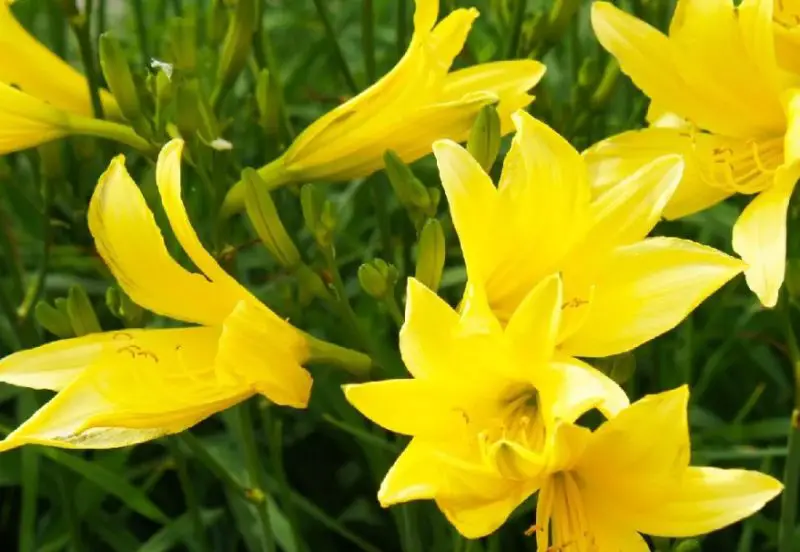
Daylilies are resilient, long-lived perennials renowned for their vivid, trumpet-shaped flowers that come in nearly every color imaginable—except true blue. Each bloom typically lasts just one day, but mature clumps produce dozens of flower buds, ensuring continuous color over several weeks. In New Mexico, daylilies are a favorite for gardeners looking to add reliable bursts of color to sunny beds, borders, and even slopes with lean, rocky soils.
These plants generally bloom from late spring through mid-summer, though many modern cultivars are rebloomers and can flower multiple times until fall. Daylilies thrive in full sun and tolerate high heat, making them well-suited to New Mexico’s intense summer conditions. Their grass-like foliage grows in dense clumps, helping to suppress weeds and conserve soil moisture. Once established, daylilies are quite drought-tolerant and rarely troubled by pests or diseases, adding to their appeal for low-maintenance landscapes.
To grow daylilies in New Mexico, plant them in full sun in well-draining soil, ideally in spring or fall. Space clumps 18 to 24 inches apart to give them room to grow. Water regularly during the first growing season to establish strong roots; afterward, they will need only occasional deep watering. Mulching around the base helps retain moisture and keeps the roots cool in peak heat. Divide clumps every 3–5 years to rejuvenate flowering and maintain plant vigor. With minimal care, daylilies will thrive and return reliably year after year.
Bearded Iris (Iris germanica)
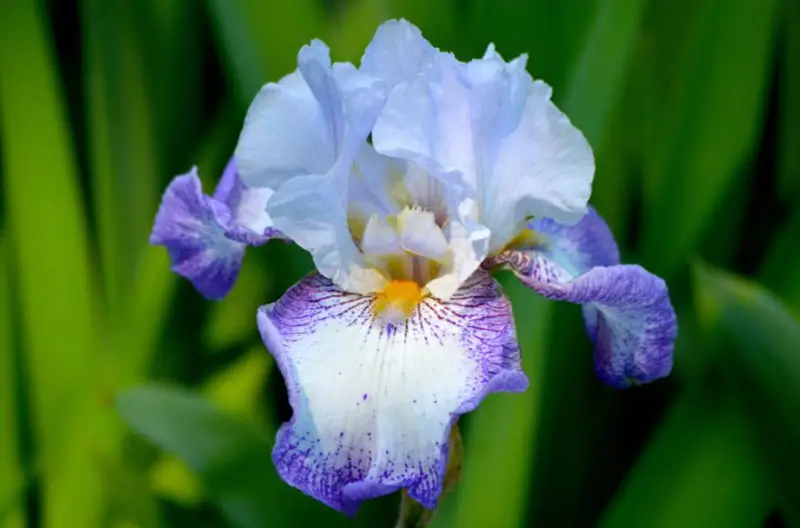
Bearded iris is a dramatic perennial celebrated for its large, ruffled flowers and sword-like foliage. The blooms appear in a wide range of shades—purples, blues, yellows, whites, and even multi-colored patterns—with each flower showcasing the distinctive “beard” of fuzzy filaments on the falls (lower petals). In New Mexico, where the high desert climate demands plants that can endure both heat and dryness, bearded iris proves itself as a hardy and ornamental favorite.
Blooming typically from mid to late spring, bearded iris flowers are a highlight in desert gardens, offering both beauty and resilience. Once established, the plants require little water and thrive in full sun, performing best in USDA Zones 4–9. Their thick rhizomes store moisture, allowing the plant to withstand periods of drought. The upright foliage remains attractive long after blooming, providing vertical interest in garden beds throughout the growing season.
To grow bearded iris in New Mexico, choose a location with at least 6 hours of sun and soil that drains quickly—sandy or gravelly soils work best. Plant the rhizomes just below the surface in late summer or early fall, with the top exposed to prevent rot. Space them about 12 to 18 inches apart for good air circulation. Water sparingly once established, and avoid heavy mulching directly over the rhizomes. Deadhead spent blooms and trim foliage in the fall. Divide clumps every 3–4 years to prevent overcrowding and ensure vigorous blooming in subsequent seasons.
Tips for Flower Gardening in New Mexico
Mulch Deeply to Retain Soil Moisture and Regulate Temperature
In New Mexico’s arid climate, mulching is essential for flower gardening success. A thick layer of mulch—about 2 to 4 inches deep—helps reduce water evaporation from the soil, keeps roots cool during scorching summer days, and suppresses weed growth. Organic mulches like shredded bark, pine needles, or composted leaves also break down slowly over time, improving soil structure. For desert-adapted plants, gravel mulch can be more appropriate, allowing heat-tolerant roots to breathe while maintaining moisture levels below the surface.
Amend the Soil with Compost to Improve Drainage and Fertility
Much of New Mexico’s native soil is sandy, rocky, or alkaline—conditions that can challenge even tough plants. Before planting, incorporate generous amounts of compost or well-rotted organic matter into the garden bed. This improves water retention in sandy soils and enhances drainage in clay-heavy areas. Compost also boosts microbial activity and supplies nutrients, giving flowers a strong start and encouraging healthy root development. For containers or raised beds, use a high-quality potting mix blended with compost to mimic these effects.
Choose Native or Adapted Species to Minimize Water Use and Maintenance
Opting for native or climate-adapted flowers ensures a thriving garden with less effort and fewer resources. Plants such as penstemons, blanket flowers, and desert marigolds are already suited to New Mexico’s high temperatures, strong sun, and seasonal droughts. These selections generally require less watering, are more resistant to local pests, and are better equipped to survive fluctuating conditions. Xeriscaping with region-appropriate plants also supports native pollinators and contributes to a more sustainable landscape.
Plant in Spring or Fall Depending on the Species and Local Elevation
Timing your planting based on elevation and species is crucial to garden success in New Mexico. In lower desert areas, early spring (February–March) is ideal before the intense summer heat arrives. In higher elevations or northern regions, late spring or even early summer may be more appropriate to avoid frost damage. Fall planting (September–October) works well for perennials, allowing roots to establish while temperatures are mild. Always check the USDA zone recommendations for your area and the plant’s cold hardiness to determine the best time to get started.
Conclusion
Growing flowers in New Mexico can be challenging, but with the right plant choices, your garden will thrive despite the harsh conditions. Selecting the best flowers to grow in New Mexico ensures lasting beauty, vibrant colors, and efficient use of water and resources.
The 12 flowers highlighted in this guide have been chosen for their adaptability, resilience, and stunning appearance. They perform well in New Mexico’s unique climate and can provide pollinator-friendly blooms or bright pops of color to any garden.
Now that you know the best flowers to grow in New Mexico, it’s time to start planting and transforming your outdoor space into a colorful desert oasis full of life.






